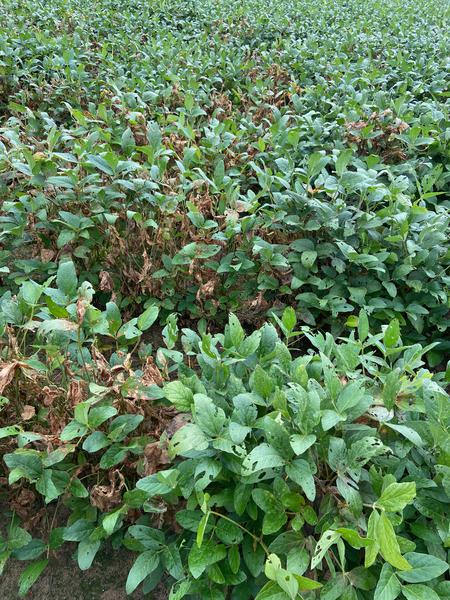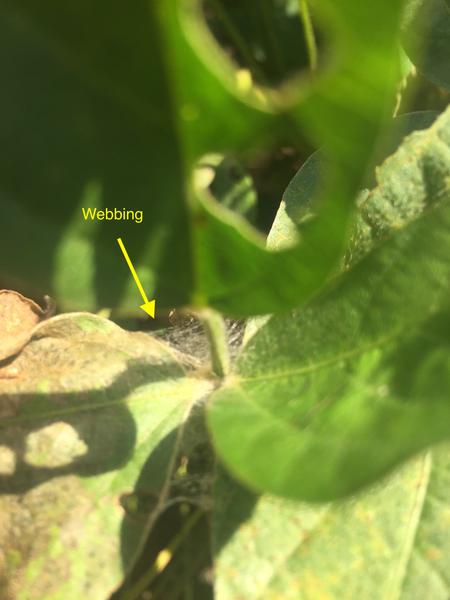Aerial Web Blight
- Scientific Name(s)
- Rhizoctonia solani
- Type
- Disease
- Leaf Condition
- Tip Burn, Distorted, Marginal Necrosis, Interveinal Necrosis, Complete Necrosis, Wilted, Brittle, Webbing On Leaves, Leaf Spot
- Leaf Color
- Patchy Yellow And Brown Areas
- Leaf Location
- Entire, Upper, Lower, Young, Mature
- Pod Condition
- Lesion
- Main Stem
- Necrotic Spots
- Petioles Condition
- Distorted, Lesion, Death
- Petioles Color
- Red
- Flowercondition
- Necrotic
- Field Distribution
- Random, Low Areas, Localized Area
- Prior Environmental
- Rain, Thunderstorm, High Temp
- Season
- Mid To Late Vegetative, Flowering, Pods Present
- Cropping System
- Soybean Followed By Soybean, Conventional Till, Reduced Till
Introduction
Aerial web blight (syn. aerial blight or Rhizoctonia aerial blight) is not a common disease for soybeans in North Carolina, but may cause local losses where conditions are conducive for development. Diagnosis can be difficult in the field because fungal structures may not be present. Because it's not a common problem for NC soybeans, the impact of management options on yield is largely unknown.
Pathogen
Rhizoctonia solani is the causal agent of aerial web blight. The fungus survives in the soil or previous crop debris as sclerotia (overwintering structures). As disease progresses, small, brown, irregularly shaped sclerotia (overwintering structures) may form inside of the web-like hyphae.
Host Range
Rhizoctonia solani has a very wide host range, and rotational crops like peanut, cotton, tobacco, and other common vegetable rotations are susceptible.
Symptoms and Signs
Initially foliage appears water-soaked, and gray-green. The foliage may become brown and necrotic where the fungus has colonized (Figure 1). Leaves stems, and pods may all be impacted. During warm, wet weather conditions, the fungus forms fungal mats over the surface of plants causing the webbed appearance. Small, irregularly-shaped, sclerotia (overwintering structures) may also be formed in the fungal mats starting out white and becoming dark brown (Figure 2).
Disease Cycle and Conditions Favorable for Disease
The fungus survives in crop debris or soil as sclerotia. Under warm, wet conditions (high humidity and 77-90°F/25-32°C) the fungus grows from sclerotia to form fungal mats over the plant surface. Disease is more severe in dense plantings or fields surrounded by trees because they increase the humidity and decrease airflow within the field. After harvest, the sclerotia survive in remaining plant debris or in the soil until suitable conditions for growth are present.
Management
There is no host resistance to aerial web blight, but some varieties may be less susceptible. Sorghum and corn are poor hosts, and rotations with those crops for two years may reduce incidence in future stands. If a susceptible crop is planted, and environmental conditions continue to be conducive to disease, a fungicide application may be beneficial. In field trials in Mississippi, fungicide applications containing a strobilurin protected yield when applied at R5.
Useful Resources
The NC State University Plant Disease and Insect Clinic provides diagnostics and control recommendations
The Extension Plant Pathology portal provides information on crop disease management
The North Carolina Agricultural Chemicals Manual provides pesticide information for common diseases of North Carolina. The manual recommendations do not replace those described on the pesticide label, and the label must be followed.
Acknowledgements
This factsheet was prepared by the NC State University Field Crops and Tobacco Pathology Lab in 2020.
- Check out our Facebook and our Twitter!




